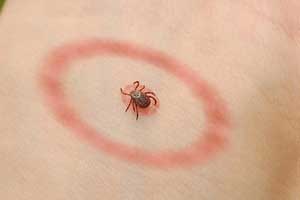- Home
- Editorial
- News
- Practice Guidelines
- Anesthesiology Guidelines
- Cancer Guidelines
- Cardiac Sciences Guidelines
- Critical Care Guidelines
- Dentistry Guidelines
- Dermatology Guidelines
- Diabetes and Endo Guidelines
- Diagnostics Guidelines
- ENT Guidelines
- Featured Practice Guidelines
- Gastroenterology Guidelines
- Geriatrics Guidelines
- Medicine Guidelines
- Nephrology Guidelines
- Neurosciences Guidelines
- Obs and Gynae Guidelines
- Ophthalmology Guidelines
- Orthopaedics Guidelines
- Paediatrics Guidelines
- Psychiatry Guidelines
- Pulmonology Guidelines
- Radiology Guidelines
- Surgery Guidelines
- Urology Guidelines
Researchers develop fast, inexpensive test for early diagnosis of Lyme disease

Lyme disease is caused by the tick-borne bacteria Borrelia burgdorferi. Early symptoms of the disease include the characteristic skin rash, along with fever, headache, chills and muscle aches. If not treated promptly with antibiotics, more severe symptoms, such as facial palsy, nerve pain, heart palpitations, and arthritis, can occur. Unfortunately existing diagnostic blood tests are slow, costly or insensitive at early stages when treatment is most effective.
Researchers have devised a blood test that quickly and sensitively diagnoses the disease at early stages. The new paper base test is fast, easy-to-use and inexpensive for diagnosing Lyme disease soon after infection.The research has been published in ACS Nano.
After a day hiking in the forest, the last thing a person wants to discover is a tick burrowing into their skin. Days after plucking off the bloodsucking insect, the hiker might develop a rash resembling a bull’s-eye, a tell-tale sign of Lyme disease. Yet not everybody who contracts Lyme disease gets the rash. Now, researchers reporting in ACS Nano have devised a blood test that quickly and sensitively diagnoses the disease at early stages.
The researchers built a handheld, paper-based device to detect antibodies against the B. burgdorferi bacteria in serum samples. The device included a sensing membrane that contained several spots covering seven bacterial antigens and a synthetic peptide. Antibodies from serum samples that attached to the spots were detected with a solution that changed colour, depending on the amount of antibody captured. The researchers took pictures of the colour changes on a smartphone, then analyzed all of the spots with a neural network they developed that could determine whether the sample was positive or negative for Lyme disease. When tested on 50 blood samples from people with or without early-stage Lyme disease, the assay had a specificity of 96.3% and a sensitivity of 85.7%. In addition to being much more sensitive than existing tests, the assay requires 15 minutes to complete and costs only 42 cents per test.
For more details click on the link: https://doi.org/10.1021/acsnano.9b08151

Disclaimer: This site is primarily intended for healthcare professionals. Any content/information on this website does not replace the advice of medical and/or health professionals and should not be construed as medical/diagnostic advice/endorsement or prescription. Use of this site is subject to our terms of use, privacy policy, advertisement policy. © 2020 Minerva Medical Treatment Pvt Ltd